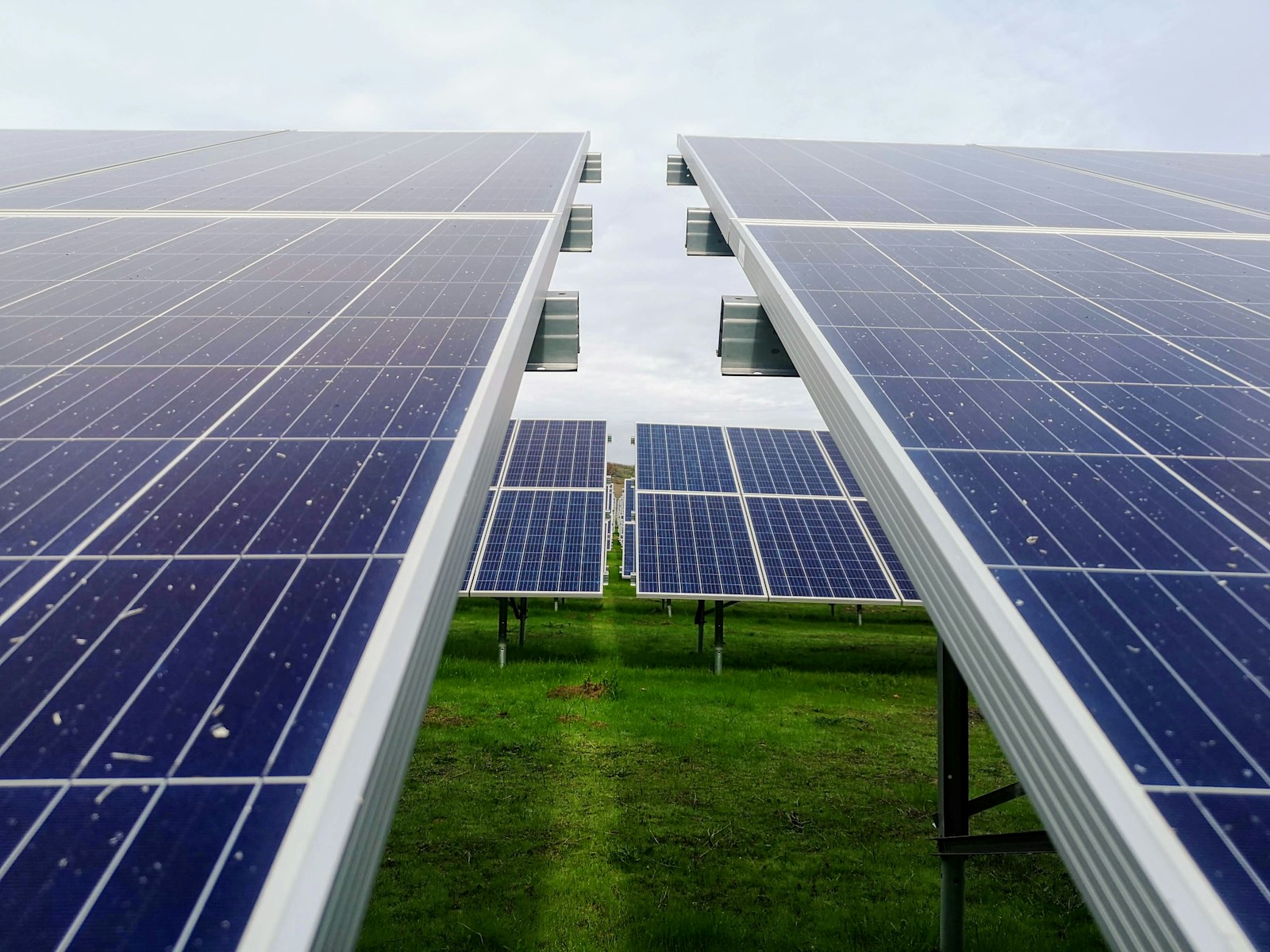Solar panels are a key technology in the movement toward renewable energy, converting sunlight into electricity to power homes, businesses, and even entire communities. But how exactly do they work? In this article, we will take a detailed look at the science behind solar panels, the components involved, and the process that transforms sunlight into usable electricity. The Basics of Solar Panels: Photovoltaic Cells At the core of every solar panel are photovoltaic (PV) cells. These cells are responsible for converting sunlight into electricity through the photovoltaic effect—a process that generates electric current when light is absorbed by a material. PV cells are typically made from semiconductors, most commonly silicon, which is highly efficient at converting sunlight into electrical energy.
The Photovoltaic Effect Explained
The photovoltaic effect involves three main steps:
- Light Absorption: When sunlight hits a photovoltaic cell, photons (particles of light) are absorbed by the semiconductor material. This energy from the photons excites electrons within the semiconductor, giving them enough energy to break free from their atoms.
- Electron Movement: Once these electrons are freed, they begin to move through the material, creating an electric current. The design of the PV cell creates an electric field that directs this flow of electrons, generating a steady current.
- Electricity Generation: Metal contacts on the top and bottom of the cell capture the electrons and transfer them through wires, resulting in a flow of direct current (DC) electricity.
The Components of a Solar Panel System
While the photovoltaic cells are the heart of the system, a fully functional solar panel setup includes several other components that work together to generate, store, and distribute electricity.
1. Solar Cells
A typical solar panel consists of many individual solar cells connected in a grid-like pattern. Each cell generates a small amount of electricity, but when combined, they produce enough power to be useful. Multiple panels can be connected together to form a solar array, increasing the overall energy output.
2. Solar Panels
The solar panels themselves are made up of these interconnected PV cells. They are protected by layers of glass, encapsulants, and a durable frame that shields them from environmental conditions like rain, wind, and debris. The panels are designed to be as efficient as possible in capturing sunlight, converting it into electricity, and minimizing energy loss.
3. Inverter
The electricity produced by solar panels is in the form of direct current (DC), which isn’t directly compatible with most home appliances or the electrical grid, which use alternating current (AC). The inverter’s job is to convert the DC electricity into AC electricity, making it usable in your home or business.
- String Inverters: Typically used in residential systems, string inverters convert the electricity generated by a group of panels connected in a series.
- Microinverters: These are installed on individual panels, optimizing the energy output from each one. They are more efficient in systems where shading or varying sunlight conditions might affect specific panels.
- Power Optimizers: Often paired with string inverters, power optimizers condition the electricity before sending it to the main inverter, improving overall efficiency.
4. Battery Storage (Optional)
Some solar systems include batteries to store excess electricity generated during the day. This stored energy can be used at night or during cloudy periods when the panels aren’t producing as much power. Battery storage is especially valuable for off-grid systems or in regions where utility prices fluctuate.
5. Net Metering and the Electrical Grid
In grid-tied systems, excess electricity generated by your solar panels can be sent back to the grid through a process called net metering. You receive credits for the energy you supply to the grid, which can offset your electricity costs. When your panels aren’t producing enough power to meet your needs, you can draw from the grid as usual.
How Do Solar Panels Generate Electricity? A Step-by-Step Process
Let’s break down the entire process of how solar panels generate electricity from sunlight:
- Sunlight Hits the Solar Panels: Solar panels absorb sunlight throughout the day. Even on cloudy days, some sunlight reaches the panels, allowing them to generate electricity (though at reduced efficiency).
- Photovoltaic Cells Produce Direct Current (DC) Electricity: The photovoltaic cells within the panels convert the energy from sunlight into DC electricity.
- Inverter Converts DC to AC Electricity: The DC electricity is sent to an inverter, which converts it to alternating current (AC) electricity, making it compatible with your home’s electrical system and the power grid.
- Electricity Powers Your Home or Business: The AC electricity flows into your electrical panel, where it is distributed to power your appliances, lighting, and other devices.
- Excess Energy is Stored or Sent to the Grid: If your system produces more electricity than you need, it can be stored in batteries (if available) or sent back to the grid for credits through net metering.
- Continuous Monitoring and Maintenance: Modern solar systems often include monitoring software that tracks energy production, usage, and system performance. Regular maintenance, such as cleaning panels and inspecting connections, ensures optimal efficiency.
The Benefits of Solar Energy
Solar energy offers a range of benefits, both for individuals and society as a whole:
- Renewable Energy Source: Solar energy is inexhaustible as long as the sun shines, making it a sustainable alternative to fossil fuels.
- Reduced Electricity Bills: By generating your own electricity, you can significantly lower or even eliminate your electricity bills.
- Environmental Impact: Solar power is a clean energy source that produces no greenhouse gas emissions, helping reduce the carbon footprint.
- Energy Independence: Generating your own power reduces your reliance on the utility grid and provides a level of energy security.
Potential Challenges and Considerations
While solar energy is promising, there are challenges and considerations to keep in mind:
- Upfront Costs: The initial cost of purchasing and installing solar panels can be high, though government incentives and tax credits can help offset the expense.
- Weather and Location Dependency: Solar panels are most effective in areas with abundant sunlight. In regions with frequent cloud cover, efficiency may be reduced, although systems still produce electricity.
- Space Requirements: To generate significant amounts of electricity, you need enough space for your solar panels, whether on your roof or on the ground.
The Future of Solar Technology
Advances in solar technology continue to improve efficiency, reduce costs, and expand the applications of solar power. Emerging technologies like solar shingles, transparent solar panels for windows, and more efficient battery storage are driving the growth of solar energy across residential, commercial, and even industrial sectors.
Practical Tips for Implementing Solar Power
Assess Your Energy Needs
Before installing a solar panel system, it’s crucial to evaluate your current energy consumption. Understanding your daily and monthly usage will help you design a system that meets your needs without overspending.
Consider Your Roof’s Condition
Ensure your roof is in good condition before installation. Solar panels typically last 25-30 years, so it’s wise to repair or replace your roof beforehand to avoid future complications.
Evaluate Local Incentives
Look into local, state, and federal incentives that can reduce the cost of your solar installation. These can include tax credits, rebates, and grants that make solar energy more affordable.
Explore Financing Options
If the upfront cost is a concern, consider financing options such as solar loans, leases, or power purchase agreements (PPAs). These can help spread the cost over time, making solar energy more accessible.
Regular Maintenance
Keep your solar panels clean and check for any obstructions, like overhanging branches, that could block sunlight. Regular inspections ensure that your system continues to operate efficiently.
Common Mistakes to Avoid
- Underestimating Energy Needs: Failing to accurately assess your energy needs can result in a system that doesn’t meet your requirements.
- Ignoring Shading Issues: Trees, buildings, and other structures can cast shadows on your panels, significantly reducing their efficiency.
- Choosing the Wrong Installer: Selecting an inexperienced or unqualified installer can lead to subpar system performance and potential safety hazards.
- Neglecting Maintenance: Overlooking regular maintenance can lead to decreased efficiency and costly repairs down the line.
Real-World Examples
Consider the case of a mid-sized company that decided to go solar. By installing a solar array on their building, they managed to cut their energy costs by 30% annually. They also took advantage of local tax incentives, which covered nearly 50% of the installation costs. This investment not only reduced their operational expenses but also enhanced their brand’s image as an environmentally responsible business.
In another example, a homeowner in a sunny region invested in solar panels along with a battery storage system. This setup allowed them to achieve energy independence, even during grid outages. By carefully planning their system size and storage capacity, they could optimize their energy use and minimize reliance on external power.
Exploring Solar Innovations
The solar industry is constantly evolving, bringing new technologies to market. For instance, bifacial solar panels capture sunlight from both sides, increasing power output. Additionally, integrating smart technology allows homeowners to monitor and control their solar systems remotely, optimizing energy usage and further reducing costs.
In urban areas, innovative solutions like solar canopies and carports provide additional space for solar installations, making them viable options for businesses and residential complexes that lack roof space.
Conclusion
Solar panels work by capturing sunlight and converting it into electricity through the photovoltaic effect. This process involves multiple components, including photovoltaic cells, inverters, and optional battery storage, working together to provide clean, renewable energy. As solar technology continues to evolve, it is becoming an increasingly viable and attractive solution for those seeking to reduce their energy costs and environmental impact. With the right setup, solar panels can power homes, businesses, and entire communities sustainably for decades to come.




